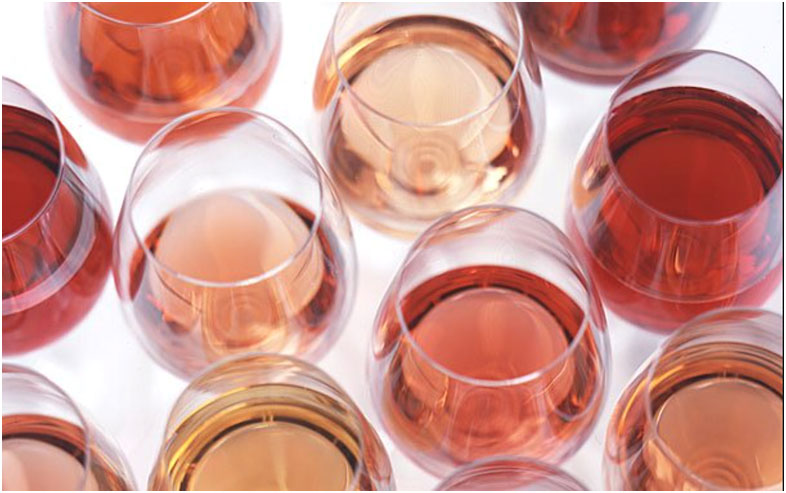The War of The Rosés - June 2019
- 03 Jun 2019
- Camilla Wood

The Conduit Magazine - June 2019 Article
by Camilla Wood, Owner/MD The Somerset Wine Company
The War of The Rosés
’Tis the season for the pink stuff
- and this begs the question why we don’t drink rosé year round like the Europeans - using our climate as an excuse seems a little churlish. But yes, a glass of rosé in the sunshine is a vinous affirmation that summer is upon us and indeed a truly life-enhancing moment.
But, rosé season also means the arrival of my favourite wine merchant’s bugbear: along with “I don’t drink Chardonnay, but I’ll take some Chablis”, is the oft-used customer claim - “I only want the palest rosé because it’s the best”. I smile through gritted teeth and produce a couple of my limpidly pink Cotes de Provence rosés attempting to counter this dogged opinion with a little wine education. 9 times out of 10 I fail and the customer leaves happily with the palest onion-skin hued rosé in the shop. Of course all sales are happy sales!
So, back to basics, rosé wines (also known as ‘rosato’ in Italy or ‘rosado’ in Spain and Portugal) must be derived from black grapes and the colour is dictated by the amount of time the winemaker chooses to leave the skins in contact with the fermenting grape juice. The major difference between a rosé and a red wine is the amount of time that the skins are allowed to macerate with the juice. This denotes the strength of colour in the resulting wine. The best rosés are dry (as opposed to the sweeter ‘Blush’ Zinfandels from the USA) and range in colour from a very pale vin gris to a deeper raspberry shade.
The paler the colour doesn’t always equal the best quality, rather that different grape varieties will denote the shade of pink or indeed the cultural tastes of the country of origin. Spanish rosé’s were always traditionally darker (as befits the Garnacha grape) but many European countries are, sadly in my view, eschewing tradition and jumping on the paler rosé bandwagon in order to grab some of the Provençal market share. Rosé wines from Tavel in the Southern Rhone are regarded as some of the world’s best gastronomic wines and are always a deeper ruby shade. Winemakers in Tavel in the Rhone would rather be seen dead than produce a pale rosé and in the war of the rosés in France would more often than not vanquish! It is worth noting that a lot of the flavour and structure of a wine comes from the grape skins so a longer maceration time can impart more flavour and complexity to the wine. So please, don’t be put off by a darker rosé and assume it to be inferior! There are many rosés which may be prettily pale but taste bland, insipid or overly acidic due to overcropped or unripe grapes.
There are three production methods for rosé wine: the Limited Maceration method, whereby grape juice is merely kissed by the skins for between 2-20 hours, the juice racked off and left to ferment into a dry wine with the palest of hues. Secondly, the Blending method where a tiny proportion of red wine (usually about 5%) is added to a vat of white wine to make rosé. This method is outlawed in Europe for still rosé wines but permitted in sparkling wine regions such as Champagne. Ruinart’s famous rosé Champagne for example is primarily Chardonnay with a smidgen of red Pinot Noir blended in.
Rosé wine in Provence started life as a by-product of red wine production. It was originally made by bleeding off the pale juice so that the rest of the wine in the tank would become a more concentrated, deeper coloured red wine - the famous tannic and powerful Mourvèdre reds of Provence are testament to that. This is known as the “Saignée” method (from the French word for bleeding) and the resulting pale-toned, simple (read cheap) wines were sold to happy tourists during the summer months. These days a more sophisticated style of Provence rosé has taken shape and is gaining popularity around the world as a fabulous year-round wine.
It is all a far cry from the ubiquitous Mateus rosé from Portugal in it’s characteristic squat bottle we consumed in the 70s and 80s. We now have an enormous range of rosés in the UK and it is the fastest growing wine category. Why? Well, apart from the fact that it lifts the spirits and makes us all get into the summer vibe, the great thing about rosé is its versatility. With its profile of summer berries and savoury, often minerally, edge heightened by refreshingly crisp acidity, it will wake up your taste buds and enhance whatever you’re eating. From an off-dry aperitif style via a deeper Italian rosé through to the driest, palest Provence rosé you can pair them with cuisine from barbecued meats to seafood, salads, cheeses or white meat dishes. Here at the Somerset Wine Company you can choose from several impressive English rosés from Pinot Noir, a Lebanese out of the famous Chateau Musar, our South African from Babylonstoren, an Italian Montepulciano or Chiaretto using the Bardolino grape, to those from several French regions: Tavel, the Loire, the Gard, Languedoc and of course, a number of Provence rosés to suit all budgets. But remember, variety is the spice of life and in the war of the rosés pale does not always claim victory. Try for yourself this summer!


TEL: 01963 548228
The Deli Castle Cary
Pitchings House
Castle Cary
Mob: 07717 396635 Shop: 01963 548228
E: info@somersetwinecompany.com
Deli: charlie@thedelicastlecary.co.uk
Opening Hours: Mon - Sat 9am - 6pm
All other times by appointment
www.somersetwinecompany.com
https://www.facebook.com/SomersetWineCompany
Twitter: @somersetwineco
Instagram: somersetwineco
LUX Guide 2017 'Best West Country Wine & Spirits Purveyor'
Runner Up as 'Newcomer of The Year' in the Drinks Retailing Awards 2016
Finalist in Muddy Stilettos 'Best Somerset Wine Merchant' 2016 & 2017




